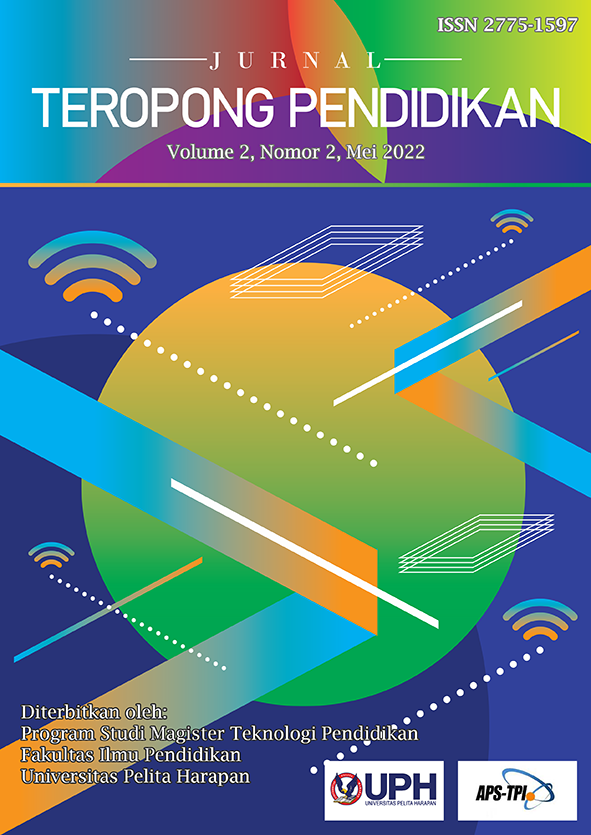Meningkatkan Keterampilan Menggambar, Menulis, dan Membaca Anak dengan Penggunaan Sandpaper Letters [Increasing Children's Drawing, Writing, and Reading Abilities with the Usage of Sandpaper Letters]
DOI:
https://doi.org/10.19166/jtp.v2i2.5702Keywords:
early childhood, sandpaper letters, different pace learners, Montessori, drawing, writing, reading, weak experimental researchAbstract
Early drawing, writing, and reading are some good aspects that can be developed to nurture children’s language acquisition from early childhood. Environment stimulation is also one of important aspects, of which includes learning resources and teacher’s awareness of the importance of personal approach toward students. The problem that is encountered by Kindergarten 2 teachers is some students have difficulties in their early drawing, writing, and reading. This issue had brought the researcher’s attention to analyze the problem and tried to find solution, which one of them is the use of Sandpaper Letters with Montessori approach to develop early drawing, writing, and reading abilities. This research is a weak experimental research to 10 Kindergarten 2 students recommended by the homeroom teachers. The treatment used sandpaper letters with the Montessori approach for six weeks with one on one session. The result from pretest and posttest of drawing skill was N-gain 0,64 (medium), the writing skills N-gain 0,7 (high), and reading skills N-gain 0,7 (high). Based on the result, it is showed that Sandpaper letters with Montessori approach could affect the improvement of difference pace learner in early drawing, writing, and reading skills at kindergarten.
References
Fraenkel, J. R., & Wallen, N. E. (2008). How to design and evaluate research in education (7th ed.). McGraw-Hill.
HighScope Educational Research Foundation. (1992). HighScope Child Observation Record (COR) for ages 2½-6. HigScope Press.
Ihsan, F. (2003). Dasar-dasar kependidikan. Penerbit Rineka Cipta.
Latipun. (2008). Psikologi eksperimen. Penerbit Universitas Muhammadiyah Malang.
Liliard, P. P. (1988). A modern approach. Schocken Books Inc.
Lloyd, S. (1992). The phonics handbook: A handbook for teaching reading, writing and spelling. Jolly Learning Ltd.
London Montessori Center Text Book (1998). Module 1; Montessori Philosophy. LMC Press.
Mulyati, Y. (2010). Pembelajaran membaca dan menulis permulaan. Universitas Pendidikan Indonesia.
Paciorek, K. M. (2002). Taking sides, clashing views on controversial issues in early childhood education. McGraw-Hill/Dushkin.
Pinnell, G. S., & Fountas, I. (2011). Literacy beginnings: A prekindergarten handbook. Heinemann.
Shaw, S. R. (2010). Rescuing students from the slow learner trap. Principal Leadership, 10(6), 12-16.
Sierles, S. (2015). The slow learner can learn!. The Clearing House: A Journal of Educational Strategies, Issues and Ideas, 36(6), 361-364. https://doi.org/10.1080/00098655.1962.11475882
Sugiyono. (2015). Metode penelitian kombinasi (mixed methods). Alphabeta.
Suparno, P. (2007). Metodologi pembelajaran fisika konstruktivistik dan menyenangkan. Sanata Darma.
Susanto, A. (2011). Perkembangan anak usia dini pengantar dalam berbagai aspeknya. Kencana Perdana Media Group.
Susanto, A. (2012). Perkembangan anak usia dini. Kencana.
Ulfa. (2013). Manfaat gambar dan menggambar bagi anak usia dini, TK, dan SD. Nizamia Andalusia School.
Yus, A. (2012). Model pendidikan anak usia dini. Kencana Prenada Media Group.
Downloads
Published
Issue
Section
License
Authors who publish with this journal agree to the following terms:
1) Authors retain copyright and grant the journal right of first publication with the work simultaneously licensed under a Creative Commons Attribution License (CC-BY-SA 4.0) that allows others to share the work with an acknowledgement of the work's authorship and initial publication in this journal.
2) Authors are able to enter into separate, additional contractual arrangements for the non-exclusive distribution of the journal's published version of the work (e.g., post it to an institutional repository or publish it in a book), with an acknowledgement of its initial publication in this journal.
3) Authors are permitted and encouraged to post their work online (e.g., in institutional repositories or on their website). The final published PDF should be used and bibliographic details that credit the publication in this journal should be included.







